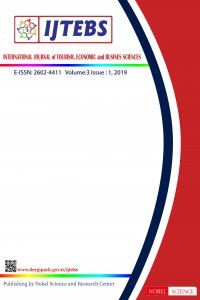THE ART OF THE PUPPETRY AS A TOURISTIC OBJECT
THE ART OF THE PUPPETRY AS A TOURISTIC OBJECT
___
- 1. İvgin, Hayrettin. (2000). Karagöz Ve Kukla Sanatımız. Ankara: Akkav Yayınları. S. 66
- 2. Roth, D. 1975 P.26. The Art Of Making Puppets& Marionettes. Pennsylvania. Usa: Chilton Book Company,
- 3. And, Metin. (1985) S: 25. Geleneksel Türk Tiyatrosu, Bilgi Yayınevi, S.102
- 4. And, Metin. (1985) S: 25. Geleneksel Türk Tiyatrosu, Bilgi Yayınevi, S.264
- 5. İvgin, Hayrettin. (2000) ‘Karagöz Ve Kukla Sanatımız’ Akkav Yayınevi S.63
- 6. Oral, Ünver. 2000, Kavuklu İş Buldu, Yayınevi Milli Eğitim Bakanlığı Yayınları, P. 19.
- 7. Durkheim, Emile. The Elementary Forms Of Religious Life, 1915, P. 65.
- 8. And, 1982, Osmanlı Şenliklerinde Türk Sanatları, Kültür Ve Turizm Bakanlığı 1982 Ps. 1-12-15 .
- 9. Boehn, Max Von (1956-1973), Puppets And Automata P. 264 Rowlands Press.
- 10. Atasoy, Nurhan (1997). 1582: Surname-İ Hümayun - Düğün Kitabı, İstanbul: Koçbank, Yayınları.
- 11. Picture1-2-3 ; Www.Pinterst.Com
- 12.Picture 4. Atıl, Esin, 1999, Levni And Sûrnâme, Koçbank, P.6
- Başlangıç: 2017
- Yayıncı: Nobel Bilim ve Araştırma Merkezi Limited
KONAKLAMA İŞLETMELERINDE KIŞI-ÖRGÜT UYUMU VE DUYGUSAL EMEK DÜZEYLERI ARASINDAKI İLIŞKININ ANALIZI
Haluk TANRIVERDİ, Dilbar GULIYEVA
ÇİFT YÖNLÜ ÖRGÜTLER DAHA MI DAYANIKLI? SAĞLIK İŞLETMELERİ ÜSTÜNDE BİR ARAŞTIRMA
Ayşe GÜNSEL, Mariana DODOUROVA
TURİZM İŞLETMELERİNDE ELEKTRONİK TİCARETİN ETKİSİ
Sami KARACAN, Sibel ÇIFTÇIOĞLU
ANALYSIS OF CONFLICTS IN HOTEL OPERATIONS AS A MANAGEMENT PROCESSES
TURİZM VE REKREASYON ROTASI BELİRLENMESİ: ÇANAKKALE ÖRNEĞİ
DÜNYADA VE TÜRKİYE’DE GASTRONOMİ TURİZMİ
Saime KÜÇÜKKÖMÜRLER, Nağme Boran ŞIRVAN, Aybuke Ceyhun SEZGIN
THE ART OF THE PUPPETRY AS A TOURISTIC OBJECT
Süheyla BAYRAKTAR, Tülay POLAT ÜZÜMCÜ
KOCAELİ’NDE TURİZMİ ÇEŞİTLENDİRME ve ALTERNATİF TURİZMDE ATILACAK ADIMLAR
